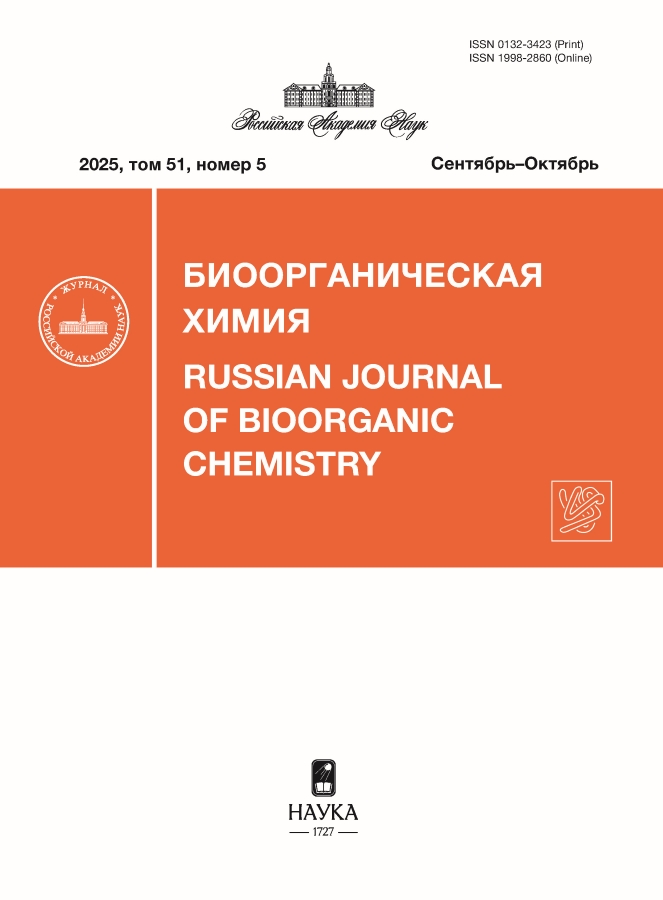Том 50, № 5 (2024)
Статьи
Особенности аминокислотного состава желатинов из органов и тканей ряда сельскохозяйственных животных
Аннотация
Желатины образуются при технологических процессах переработки белков соединительной ткани животных (прежде всего коллагенов) и с биохимической точки зрения представляют собой различные полипептидные продукты. В большинстве случаев желатины, как коммерческие продукты, на 52.5% производятся из кожи и костей крупного рогатого скота (КРС), на 46.0% – из кожи свиней и только на 1.5% – с использованием других видов животных. В начале XXI века основная масса произведенных желатинов используется в пищевых продуктах, около трети – в медицинском секторе и только ~6% – в технических или других областях промышленности. В настоящее время усилилась тенденция к здоровому образу жизни, что, наряду с религиозно-культурными традициями многих стран, побуждает ученых искать источники желатинов, не относящиеся к млекопитающим, но близкие к ним по физико-химическим и функциональным характеристикам. Поэтому в последнее время появилась тенденция к некоторому снижению гигантского объема производства желатинов из млекопитающих (КРС и свиней), но пока несущественному по сравнению с относительным ростом производства желатинов из субпродуктов и отходов промышленного птицеводства, тем более что за последние десятилетия мировое производство мяса птицы выросло более чем на треть. Показано оптимальное содержание аминокислот (АК) и их соотношений в желатинах из кожи КРС и свиней для их дальнейшего использования. Конечно, содержание АК в желатинах из кожи свиньи и КРС, определенное в различных технологических условиях, может существенно отличаться, но в целом эти отличия носят не критический характер, поэтому иногда желатины получают из смеси отходов животноводства. Недавно в России была предложена композиция белковых ингредиентов из гидролизатов кожи свиньи и КРС с добавками высушенной плазмы крови, которая имела более “ценный” АК-состав, чем в традиционных желатинах, что позволило авторам сделать предположение о повышенной биологической и пищевой ценности разработанного продукта. Кроме того, ряд авторов обнаружил улучшение отдельных показателей и биологических свойств желатинов из смеси отходов животноводства при образовании некоторых специфических пептидов. Таким образом, в настоящее время активно разрабатываются новые композиции на основе известных желатинов с оптимальным АК-составом, способствующим улучшению питательных и функциональных свойств. Научная и практическая значимость данного обзора заключается в детальном описании основных исследований по АК-составу желатинов и выявлении взаимосвязи их АК-состава с ключевыми биохимическими и технологическими показателями материалов на основе желатинов.
 577-590
577-590


Разработка метода флуоресцентно-констрастирующего иммуноокрашивания для 3D-визуализации астроцитарной ультраморфологии
Аннотация
Изменение астроцитарной ультраморфологии может лежать в основе развития нейродегенеративных процессов на их ранних стадиях. Однако механизмы ее изменения до настоящего времени изучены мало, поскольку размеры периферических астроцитарных отростков, формирующих основу астроцитарного синаптического покрытия, лежат за пределами разрешающей способности большинства методов оптической микроскопии (ОМ). В свою очередь, недостатком перспективных для таких исследований методов электронной (ЭМ) и сканирующей зондовой микроскопии (СЗМ) является отсутствие возможности определения целевого участка исследования за счет одновременного использования флуоресцентной микроскопии иммуноокрашенных клеток и возможности полноценного 3D-анализа образцов. В данной работе рассмотрена концепция решения вышеуказанной проблемы за счет применения инструментального подхода, объединяющего в рамках единого аппаратного комплекса методы СЗМ и ОМ совместно с ультрамикротомией в качестве метода восстановления 3D-структуры образца. Для реализации предлагаемой комбинированной методики (оптико-зондовой нанотомографии) в данной статье представлена разработка первой стадии создания специализированных флуоресцентно-контрастирующих меток на основе конъюгатов флуоресцентных полупроводниковых нанокристаллов и однодоменных антител. Такой тип метки обеспечит как иммуноокрашивание “зоны интереса” для восстановления 3D астроцитарной ультраморфологии, так и контрастирование астроцитов методом СЗМ.
 591-600
591-600


Производные 3-гидроксихиназолина, аналоги эрастина, индуцируют ферроптоз в клетках колоректального рака
Аннотация
В последние годы достигнут значительный прогресс в лечение больных раком толстой кишки, однако в большинстве случаев лечение сопровождается развитием лекарственной резистентности. Обнаруженная недавно железозависимая гибель клетки, ферроптоз, позволяет надеяться на продление периода ремиссии. В работе изучена возможность индукции ферроптоза в клетках рака толстой кишки новыми производными 3-гидроксихиназолина. Исследования проводили на двух клеточных линиях рака толстой кишки HCT-116 и DLD-1. Гибель опухолевых клеток по типу ферроптоза идентифицировали по уровню перекисного окисления липидов. Уровень перекисного окисления липидов в клетках НСТ-116, индуцируемый некоторыми производными 3-гидроксихиназолина, приближался к активности референтного препарата эрастина. Картина существенно менялась при исследовании индукции ферроптоза в клетках DLD-1. Два производных 3-гидроксихиназолина индуцировали уровень перекисного окисления липидов в клетках DLD-1, превышающий этот показатель у эрастина. Полученные предварительные результаты позволяют предположить, что три новые соединения могут рассматриваться в качестве противоопухолевых средств для лечения рака толстой кишки, а также указывают на перспективность дальнейшего поиска индукторов ферроптоза среди производных 3-гидроксихиназолина.
 601-611
601-611


Структурно-функциональные особенности белок-полисахаридных комплексов на основе цистеиновых протеаз и гидрофильно модифицированного хитозана
Аннотация
Получены комплексы цистеиновых протеаз – бромелина, папаина и фицина – с привитым сополимером хитозана и поли-N,N-диметиламиноэтилметакриалата. В ходе исследования установлено, что каталитическая активность ферментов в комплексах снижается по сравнению с их нативными формами. Результаты молекулярного докинга показали, что модифицированный полисахарид располагается в каталитическом кармане глобул цистеиновых протеаз. Полученные комплексы обладают повышенной стабильностью при хранении в физиологических условиях, что делает их перспективными кандидатами для использования в разработке средств терапии раневых поражений мягких тканей.
 612-621
612-621


Подход к получению циклических фоторасщепляемых РНК для фотоактивируемой системы CRISPR/Cas9
Аннотация
Создание управляемых систем редактирования генома на основе технологии CRISPR/Cas – актуальная задача современной молекулярной биологии и генетической инженерии. Интересный вариант ее решения – модификация направляющих РНК путем введения фоточувствительных групп. Мы разработали подход к получению циклических фоторасщепляемых направляющих CRISPR РНК (crРНК) для системы CRISPR/Cas9, содержащих линкеры на основе 1-(2-нитрофенил)-1,2-этандиола (PL). В циклизованном состоянии такие направляющие РНК нефункциональны, а при облучении УФ-светом они линеаризуются, индуцируя активацию системы CRISPR/Cas9. Опробованы два химических подхода к образованию циклической РНК на основе реакции Михаэля (тиол-малеимидная конденсация) и медь-катализируемого азид-алкинового циклоприсоединения (реакция “клик”-химии). Для этого получены 5′,3′-модифицированные РНК, содержащие соответствующие реакционные группы. Продемонстрировано преимущество реакции азид-алкинового циклоприсоединения для получения циклических РНК. Эффективность образования циклических РНК зависит от их вторичной структуры и возможности сближения реакционных групп в пространстве. Получены серии фоторасщепляемых циклических crРНК и их контрольных нерасщепляемых аналогов. Показано, что циклические направляющие crРНК менее эффективно направляют нуклеазу Cas9 для расщепления плазмиды, при этом линеаризация фоторасщепляемых циклических crРНК значительно увеличивает эффективность расщепления плазмиды. Разработанный подход позволяет получать циклические фоторасщепляемые РНК, в том числе направляющие РНК для активации геномного редактирования CRISPR/Cas9 в заданный момент времени в определенном месте. Фоторегуляция геномного редактирования позволит снизить нежелательные нецелевые эффекты и проводить редактирование более прицельно.
 622-635
622-635


Синтез пептидных фрагментов гликопротеина Spike SARS-CoV-2 и изучение их связывания с клетками крови человека
Аннотация
Апробирован новый метод, позволяющий оценивать активацию лейкоцитов крови синтетическими пептидами, которые представляют собой фрагменты поверхностного гликопротеина Spike SARS-CoV-2 – Lys-Ile-Ala-Asp-Tyr-Asn-Tyr-Lys-Leu (417–425 а.о.) и Val-Arg-Gln-Ala-Pro-Asn-Gly-Gln-Thr (407–415 а.о.). Установлено, что данные пептиды, вне зависимости от HLA-A-фенотипа обследуемых добровольцев, могли связываться с лейкоцитами, что говорит об универсальности реакции клеток врожденного иммунитета на эти пептиды. Пептид Lys-Ile-Ala-Asp-Tyr-Asn-Tyr-Lys-Leu связывался с лейкоцитами крови, активировал лимфоциты и базофилы, что подтверждено увеличением уровня IFN-g по сравнению с пептидом Val-Arg-Gln-Ala-Pro-Asn-Gly-Gln-Thr. Таким образом, данная работа демонстрирует подход к разработке новой пептидной вакцины против COVID-19 на этапе исследований in vitro.
 636-648
636-648


АТР-зависимые LonBA-протеазы бацилл и клостридий
Аннотация
Семейство Lon-протеаз относится к ключевым пептидгидролазам системы контроля качества белков (СКК), которая играет ведущую роль в поддержании сохранности клеточного протеома во всех природных царствах. При этом Lon-протеазы – единственное семейство АТР-зависимых протеаз СКК, которое объединяет целый ряд структурно различных подсемейств. Недавно было выдвинуто предположение о наличии в семействе Lon ранее неклассифицированного подсемейства LonBA, включающего ферменты бактерий классов Bacilli и Clostridia. С помощью биоинформатического анализа получены данные об особенностях строения ферментов предполагаемого нового подсемейства и о существовании двух различающихся групп Lon-протеаз в этом подсемействе.
 649-656
649-656


Boc/Bzl-твердофазный синтез пептида дельторфина II и его аналогов без применения безводного фтористого водорода
Аннотация
Токсичность безводного фтористого водорода – ключевой фактор поиска альтернативных кислот Льюиса для проведения процессов глобального удаления защитных групп и снятия пептидов с полимерной подложки на последней стадии их Boc/Bzl-синтеза. В отличие от фтористого водорода, эти кислоты – высококипящие соединения, но благоприятные физико-химические свойства большинства пептидов позволяют отделить целевой продукт от избытка кислот посредством метода переосаждения. Мы обнаружили, что этот метод не применим для синтеза образцов пептида дельторфина II и его аналогов, в связи с чем были исследованы иные способы их выделения и очистки. В результате были разработаны альтернативные методы синтеза, выделения и эффективной очистки пептидов класса дельторфина II. Новые подходы могут найти применение в синтезе других гидрофобных пептидов.
 657-664
657-664


ПИСЬМА РЕДАКТОРУ
Получение активных аминогрупп на поверхности полиэтилентерефталатной пленки и их количественная оценка для технологии биологических микрочипов
Аннотация
Разработан метод получения активных аминогрупп на поверхности подложки из полиэтилентерефталата (ПЭТ). Разработан метод количественной оценки концентрации и распределения химически доступных аминогрупп на поверхности ПЭТ-подложки с использованием цианинового красителя Cy5 и цифровой флуоресцентной микроскопии. Аминогpуппы могут быть использованы для дальнейшей xимичеcкой модификации поверхности ПЭТ, прививки различных функциональных групп и ковалентного cвязывания c биомолекулами, что открывает перспективы широкого использования недорогого ПЭТ в качестве функциональных подложек в биочипах, биосенсорах, устройствах “лаборатория на чипе” и других биотехнологических приложениях.
 665-671
665-671


Иммобилизация белковых зондов на биочипах с ячейками из щеточных полимеров
Аннотация
Изучены способы получения на поверхности полиэтилентерефталатных полимерных подложек полимерного покрытия из поливинилацетата и последующего получения методом фотоиндуцированной радикальной сополимеризации акрилатных мономеров щеточных полимеров. Методом фотолитографии сформированы матрицы ячеек с многочисленными реактивными химическими группами для последующей иммобилизации белков. Апробированы способы активации карбоксильных групп на щеточных полимерах, прикрепленных к поверхности полиэтилентерефталата. Выполнена иммобилизация модельного белка стрептавидина, маркированного флуоресцентным красителем Су3, для проверки метода активации карбоксильных групп. На модели “стрептавидин – биотинилированный иммуноглобулин” апробирован вариант иммунофлуоресцентного анализа в формате биологического микрочипа. Стрептавидин, иммобилизованный в ячейках из щеточных полимеров, сохраняет функциональность и пространственную доступность для связывания с биотинилированным иммуноглобулином и последующим проявлением антителами, флуоресцентно меченными красителем Cy5, что открывает перспективы использования биологических микрочипов с ячейками из щеточных полимеров на подложках из полиэтилентерефталата для иммунофлуоресцентного анализа различных белковых мишеней.
 672-685
672-685


Выявление мутаций генов IDH1/2 в образцах опухоли c низкой представленностью мутантного аллеля
Аннотация
Определение драйверных мутаций в опухоли – крайне важная задача в онкологии для выбора стратегии лечения и оценки эффективности терапии. Во многих случаях, особенно при мониторинге заболевания, возникает необходимость выявления малого количества копий мутантного аллеля на фоне избыточного содержания ДНК дикого типа. В данной работе исследованы возможности высокочувствительной детекции мутаций в генах IDH1 и IDH2 при подавлении амплификации ДНК дикого типа с помощью олигомеров “замкнутых” нуклеиновых кислот (locked nucleic acid, LNA) с последующей гибридизацией флуоресцентно меченого продукта полимеразной цепной реакции на биологическом микрочипе (биочипе). Предел обнаружения мутантной ДНК составляет 0.1% на фоне ДНК дикого типа. Эффективность данного подхода продемонстрирована на примере анализа 26 образцов хондроидных опухолей и глиальных опухолей мозга с низкой представленностью мутантного аллеля, в трех случаях были выявлены ранее не обнаруженные мутации R132C, R132L и R132H.
 686-693
686-693


Использование флуоресцентной времяразрешенной микроскопии для повышения селективности флуорогенных красителей ряда арилиден-имидазолонов в отношении эндоплазматического ретикулума
Аннотация
С использованием флуоресцентной времяразрешенной микроскопии (FLIM) был изучен набор синтезированных ранее флуорогенов ряда арилиден-имидазолонов, преимущественно окрашивающих эндоплазматический ретикулум (ЭПР) живых клеток. Показано, что использование этого типа флуоресцентной микроскопии позволяет повысить селективность окрашивания ЭПР.
 694-701
694-701










